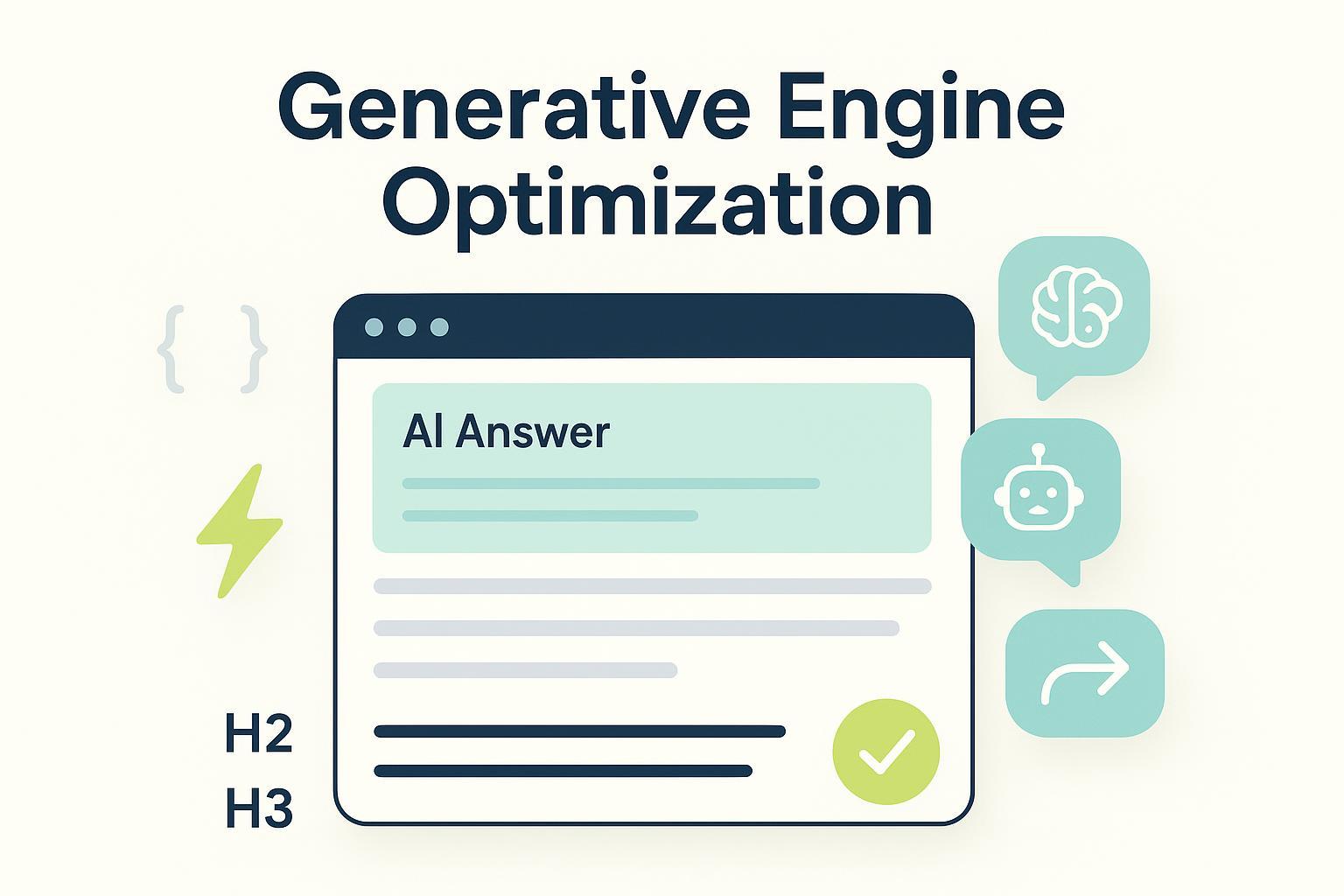Schema Markup Playbook for Product-Rich AI Overviews
Boost product visibility with the Schema Markup Playbook. Learn how structured data enhances AI-driven search results, rich snippets, and user engagement.


Imagine your product listings standing out in search results with the help of a Schema Markup Playbook. They can show reviews, pictures, and prices in rich snippets. Schema markup helps by adding organized data to your pages, making it easier for AI systems to understand and display your content better. Microsoft says their AI tools use schema markup to read websites, highlighting the importance of schema markup for AI summaries.
This guide, based on the Schema Markup Playbook, helps you improve visibility and get more attention. You can achieve more clicks, visitors, and better user interaction. Using schema markup automation makes the process easier for you, ensuring your product-rich AI summaries remain competitive.
Key Takeaways
Schema markup helps search engines understand your website content better.
Product schema shows details like price and reviews in search.
This can boost clicks and make people more interested in your site.
FAQ schema lets you answer common questions right in search results.
This improves user experience and helps people trust your website.
Check and update your schema often to keep it correct and useful.
Using structured data can bring more visitors and increase sales.
Some businesses see up to 30% more money after using it.
What Is Schema Markup and Why Does It Matter?
Definition and Purpose of Schema Markup
Schema markup is structured data that helps search engines understand websites. It uses a shared vocabulary to label details on web pages. For example, it can tag a product’s name, price, or reviews. This helps AI systems show your content in rich snippets, which are eye-catching search results.
The idea of schema markup started with Tim Berners-Lee’s Semantic Web in 1999. In 2011, Google, Bing, and Yahoo created Schema.org to standardize structured data. Today, schema markup is key for SEO, especially for online stores and local businesses. It ensures your products and services look clear and appealing in AI-powered search results.
Schema Type | Purpose |
|---|---|
Product & Offer | Displays product details and reviews, boosting clicks in search results. |
FAQ | Marks up common questions, improving visibility and user experience. |
Review | Shows ratings and reviews, building trust and credibility. |
LocalBusiness | Highlights business info like hours and location for better local SEO. |
How Schema Markup Enhances AI-Driven Search Results
Schema markup gives AI systems clear context about your content. This improves how accurately AI tools display your information. For example, adding structured data to product pages lets AI show pricing and availability instantly. This ensures your products appear in AI summaries with correct details.
Studies show schema markup can double organic traffic to websites. It also cuts crawl errors by 30%, making your site easier for search engines to access. Using schema markup makes your content easier to find and more relevant in AI-driven searches.
Benefits of Schema Markup for Product Visibility
Adding schema markup to product pages has many benefits. It increases the chance of your products showing in rich snippets, which get four times more clicks. This leads to better engagement and higher sales. Businesses using schema markup report a 20-30% rise in sales and a 10-15% revenue boost.
Schema markup speeds up indexing by 40%, making products visible faster. It also improves chances of appearing in Google Shopping results, increasing visibility by 35-40%. These advantages make schema markup a must-have for optimizing product pages and staying ahead in AI-driven searches.
Key Schema Types for Product-Rich AI Overviews

Knowing the right schema types is key to making product-rich AI overviews. Each type has a special role in showing your products clearly. These schemas help AI systems understand and display your content better. Let’s look at the most useful schema types and how they improve product pages.
Product Schema for Detailed Product Information
Product schema is very important for online stores. It gives search engines details like product name, price, stock, and reviews. This data helps your products show up in rich snippets, which attract more clicks.
For example, Google’s AI uses structured data to show product details correctly. With product schema, you can highlight key features like:
Description | |
|---|---|
Name | The product's official name. |
Description | Details about the product's features and benefits. |
Image | Clear pictures of the product. |
Category | The product's type or group. |
Brand | The company or maker of the product. |
Price | The cost, including discounts. |
Availability | If the product is in stock. |
Reviews and Ratings | Customer feedback and star ratings. |
Using product schema with GTIN can boost shopping visibility by 39%. It also improves click rates and makes product details easier to understand. Adding this schema helps AI show accurate product info, increasing clicks and user interest.
FAQ Schema for Common Questions
FAQ schema helps answer common customer questions directly in search results. It lets you mark up questions and answers for rich snippets. These snippets make your site more visible and give quick answers to users.
For example, businesses using FAQ schema saw a 28% rise in citations. One pharmacy ranked for 8.7K extra keywords in "People Also Ask," gaining over 1 million visits monthly. Answering questions upfront builds trust and removes buying doubts.
Benefits of FAQ schema include:
Better keyword rankings and visibility.
Higher user engagement by solving concerns fast.
Showing your site as an expert in your field.
Adding FAQ schema to product pages helps AI show helpful info in search results. This makes your content easier to find and more engaging.
Review Schema for User Feedback
Review schema shows ratings and reviews in search results. It builds trust and makes users more likely to click your product. Seeing stars and positive feedback attracts attention.
Websites using review schema often see big improvements:
Organic traffic grows by 45% in three months.
Click rates rise by 35% due to rich snippets.
User engagement, like time spent on pages, increases by 25%.
For example, adding review schema can make your listings stand out with star ratings. This boosts clicks and shows your products are reliable. Structured data like this helps AI display user feedback correctly, bringing more visitors and sales.
Pro Tip: Use review schema with product schema for the best results. Together, they show product details, prices, and customer opinions clearly.
By using these schema types, you can make your product pages better for AI searches. This leads to more visibility, clicks, and sales.
Extra Schema Types: Offer, AggregateRating, and How-To
Adding more schema types like Offer, AggregateRating, and How-To can improve your product pages. These schemas give search engines and AI tools extra details. This helps them show your content in ways that attract users and boost engagement. Let’s break down how these schemas work and why they’re helpful.
Offer Schema for Deals and Prices
Offer schema highlights important details about prices, discounts, and stock. It’s great for online stores because it shows deals right in search results. For example, if you have a sale, Offer schema can display both the sale price and the original price. This creates urgency for shoppers.
Key parts of Offer schema include:
Price: The product’s current cost.
Price Valid Until: When the deal ends.
Availability: If the product is in stock.
Discount: The amount or percentage off.
Using Offer schema makes your listings more attractive and clickable. It ensures AI tools show accurate prices, which builds trust with buyers.
AggregateRating Schema for Trustworthy Reviews
AggregateRating schema shows your product’s average rating from reviews. This builds trust and helps buyers pick your product over others. Seeing stars and good reviews in search results makes people more likely to click.
Why AggregateRating schema matters:
58% of shoppers care most about star ratings.
54% of users visit sites after reading good reviews.
84% of people trust online reviews like personal advice.
Statistic | Percentage/Value |
|---|---|
Buyers who find star rating most important | 58% |
People who visit the website after reading positive reviews | 54% |
Consumers who trust online reviews as much as personal recommendations | 84% |
Purchasers who read fewer than 10 reviews before making a decision | 90% |
Potential clients who think reviews older than 3 months have lost relevancy | 3% |
U.S. adults who read online ratings or reviews before making a purchase | 82% |
Adding this schema ensures AI tools show ratings clearly. This increases visibility and builds trust with shoppers.
How-To Schema for Step-by-Step Help
How-To schema gives step-by-step guides directly in search results. It’s useful for products needing assembly, setup, or special instructions. For example, a furniture store can use it to show how to assemble items. This makes things easier for customers.
Benefits of How-To schema:
Better user experience: Clear steps without extra clicks.
More engagement: Guides keep users on your site longer.
Higher visibility: AI favors content that answers questions fast.
To use How-To schema, add data for each step, plus pictures or videos if possible. This makes your content more helpful and interactive, leading to more sales.
By using Offer, AggregateRating, and How-To schemas, you can make your product pages more engaging. These schemas improve visibility, build trust, and help drive sales.
How to Add Schema Markup: A Step-by-Step Guide

Adding schema markup to your site might seem tricky. Breaking it into steps makes it simple. This guide shows how to pick key pages, create schema markup with JSON-LD, and add it to product pages. Follow these steps to improve your structured data and boost AI search visibility.
Picking Important Pages for Schema Markup
Start by choosing pages that benefit most from schema markup. Not every page needs it, so focus on high-traffic ones for the best results.
Evidence Description | Key Insight |
|---|---|
Schema markup enhances visibility and indexing of web pages. | It improves search engine recognition and user engagement, identifying key pages for schema. |
Structured data helps establish relationships between web pages. | High-quality pages support industry niche and business growth through interlinking. |
Implementing structured data is valuable for small businesses. | Marking strong topics helps establish expertise in the industry. |
Schema markup categorizes content for search engines. | It aids in displaying niche-specific search engine results pages (SERPs). |
Learning to rank in AI Overviews benefits all niches. | Understanding schema helps in optimizing content for better visibility in AI-driven searches. |
Focus on pages like product listings, FAQs, and category pages. These pages often bring the most visitors and sales. For example, e-commerce sites should prioritize pages with product details, prices, and reviews. These help AI create rich snippets that attract clicks.
Pro Tip: Use tools like Google Analytics to find your top-performing pages. These are great candidates for schema markup.
Making Schema Markup with JSON-LD
After picking pages, the next step is creating schema markup. JSON-LD is a popular format because it’s easy to use and works well with search engines.
Here are three ways to make schema markup:
Manual Coding: Write JSON-LD code yourself. It gives control but needs coding skills.
Google’s Structured Data Markup Helper: A tool that creates JSON-LD based on your input.
WordPress Plugins: Tools like Yoast SEO make it easy for WordPress users.
Source | Evidence |
|---|---|
Understanding the Practical Guide to Schema Markup for Local SEO | Implementing local SEO schema enhances visibility in search results, leading to improved rankings and higher click-through rates (CTR). |
Schema Markup 2024: SEO Best Practices for Supercharged Visibility | JSON-LD is favored by Google, enhancing credibility and trust, which contributes to better SEO outcomes. |
JSON-LD SEO: Why JSON-LD Schema Is Crucial for SEO | Rich snippets generated by JSON-LD can improve CTR by as much as 30%, making it essential for competing in organic search. |
For example, JSON-LD can add structured data to product pages. It includes details like name, price, and reviews. This format helps AI understand and show your content clearly.
Here’s an example of JSON-LD code for a product page:
{
"@context": "https://schema.org/",
"@type": "Product",
"name": "Wireless Headphones",
"image": "https://example.com/images/headphones.jpg",
"description": "High-quality wireless headphones with noise cancellation.",
"brand": "AudioTech",
"offers": {
"@type": "Offer",
"price": "99.99",
"priceCurrency": "USD",
"availability": "https://schema.org/InStock"
},
"aggregateRating": {
"@type": "AggregateRating",
"ratingValue": "4.5",
"reviewCount": "120"
}
}
Note: Always check your JSON-LD code with Google’s Rich Results Test. This ensures it’s correct and ready to use.
Adding Schema Markup to Product Pages
After creating schema markup, the last step is adding it to your product pages. This involves placing the JSON-LD code in your website’s HTML. Here’s how:
Access Your Website’s Code: Use your CMS or FTP to open the HTML files.
Add the JSON-LD Code: Place the code in the
<head>or<body>section.Test Your Work: Use tools like Google Search Console to check if it works.
Company | Result Description |
|---|---|
Rotten Tomatoes | |
The Food Network | 35% increase in website visits with enhanced search features |
Rakuten | Users spent 1.5x more time on pages with structured data |
Adding schema markup ensures AI shows your content correctly in search results. Companies like Rotten Tomatoes and Rakuten saw big gains in clicks and engagement after using structured data.
Pro Tip: Check your schema markup performance often with Google Search Console. Fix any issues quickly to keep your data working well.
By following these steps, you’ll learn how to add schema markup easily. This improves your product visibility, boosts AI search results, and brings more visitors to your site.
Checking Schema Markup with Google’s Rich Results Test
After adding schema markup, it’s important to check if it works. Google’s Rich Results Test is a helpful tool for this. It checks your schema markup to ensure it’s correct and ready for rich search results. This step makes sure your data is error-free and improves how AI shows your content.
Why Check Your Schema Markup?
Checking schema markup is very important. First, it helps search engines understand your data correctly. Mistakes in your schema can stop your content from showing in rich results. Second, it helps you find and fix problems before they hurt your site. Lastly, it ensures your data follows Google’s rules, increasing the chance of being featured in AI summaries.
Pro Tip: Check your schema markup often to match Google’s latest rules.
Steps to Use Google’s Rich Results Test
Google’s Rich Results Test is easy to use and gives quick feedback. Follow these steps to check your schema:
Open the Tool
Go to the Google Rich Results Test page. You can test a live URL or paste your schema code.Input Your URL or Code
Enter the page URL you want to test or paste your JSON-LD code into the tool.Run the Test
Click "Test URL" or "Test Code." The tool will scan your data and show results quickly.Check the Results
The tool will tell you if your schema is valid. It will also show errors or warnings. Errors need fixing, while warnings suggest improvements.Fix Problems
Correct any errors or warnings the tool finds. For example, add missing fields to your schema. After fixing, run the test again to confirm.Track Performance
Use Google Search Console to monitor how your schema performs. This ensures your data keeps working well.
Why Use Google’s Rich Results Test?
Using this tool has many benefits:
Better Accuracy: Makes sure your data is correct and easy for search engines to read.
Higher Visibility: Boosts chances of showing in rich results, which get more clicks.
Saves Time: Quickly finds issues, saving time compared to manual checks.
AI-Friendly: Prepares your data for AI searches, helping your content stand out.
By checking your schema markup, you can make the most of structured data. This improves your site’s performance in AI-powered searches and keeps you ahead of competitors.
Note: Always recheck your schema markup after making website changes. This keeps your data accurate and effective.
Advanced Strategies for Optimizing Schema Markup
Making Schema Markup Work for Voice Search
Voice search is growing fast as a way people use search engines. To make your schema markup work for voice search, keep answers short and clear. AI tools like voice assistants often use featured snippets. Adding FAQ schema to answer common questions helps your content show up. For example, marking "What is the price of wireless headphones?" makes it easier for voice search to find.
Focus on long-tail keywords and natural phrases. These match how people talk when using voice search. Adding How-To schema can also help, especially for step-by-step guides.
Tip: Use Google’s Structured Data Markup Helper to create voice-friendly schema. Test your data often with Google’s Rich Results Test to fix errors.
Using Structured Data for AI Citations
Structured data helps AI understand and organize your content better. Adding advanced schema markup gives context that improves how AI reads your pages. For instance, Product schema lets AI show correct details like price and stock in search results.
AI-powered search engines depend on structured data for rich results. This boosts your chances of being featured in AI summaries. Breadcrumb schema also helps by making navigation clearer, linking your content to user queries.
Pro Tip: Update your schema markup regularly to match your latest content. This keeps AI tools showing the most accurate details.
Improving Accessibility with Schema Markup
Schema markup doesn’t just boost visibility; it also makes content easier to access. For example, healthcare sites can use structured data to highlight locations and services. Search results with schema often show extra details like dates and contacts, which engage users more.
Adding How-To schema or FAQ schema can lower bounce rates by giving quick answers. This helps all users, including those using assistive tools, by offering clear and organized information.
Note: Schema markup makes search results more useful and attractive. This leads to better user engagement and more clicks.
Common Pitfalls and Best Practices
Avoiding Over-Optimization of Schema Markup
Adding too much schema markup can hurt your site. Search engines might punish your site if the schema doesn’t match your content. For example, using unrelated schema types or adding too much structured data can confuse AI tools. This could lower your rankings or even remove your site from search results.
To prevent this, make sure your schema matches your page content. Use tools like Google’s Rich Results Test to check for errors. Fix any problems quickly to avoid losing visibility. Also, only use schema types that fit your content. For instance, if your page is about a product, focus on Product and Offer schema instead of unrelated ones.
Tip: Keep up with schema rules to avoid penalties. Following the latest guidelines helps your structured data work better.
Ensuring Accuracy and Relevance of Structured Data
Correct and useful schema markup is key for better AI search results. Wrong or old schema data can confuse search engines and hurt your rankings. For example, if your product price changes but the schema isn’t updated, users might stop trusting your site.
Check your schema markup often to keep it accurate. Make sure it matches what’s on your pages. Use data that helps users, like AggregateRating schema for products with reviews. Avoid adding extra or unrelated data, as it wastes time and lowers the value of your schema.
Pro Tip: Use Google Search Console to track how your schema is doing. This helps you find and fix issues to keep your data effective.
Keeping Schema Markup Updated for Changing Content
When your site changes, your schema markup needs updates too. Old schema data can confuse search engines and lower your visibility. For example, if you add new products or change prices, outdated schema can show wrong details in search results.
Set a schedule to update your schema regularly. Review your pages and adjust the data to match any changes. This helps AI tools show the right information. For instance, updating Offer schema with new prices or stock details can improve your chances of appearing in rich snippets.
Process | Benefit |
|---|---|
Explaining content to search engines | |
Boosting visibility in search results | Increases chances of showing in rich snippets, leading to more clicks. |
Improving SEO results | Makes indexing and categorizing your content easier. |
Helping AI-driven searches | Ensures AI tools provide accurate answers, especially for voice search. |
Supporting Knowledge Graph links | Connects your content to external databases for better relevance. |
Enhancing user experience | Makes search results clearer and more helpful for users. |
Note: Regularly checking your schema keeps it aligned with your content. This helps maintain good search rankings and user trust.
Testing and Watching Schema Performance Often
Testing your schema markup often helps it work well. It also ensures it meets AI search needs. Watching key metrics shows where to improve and boosts your structured data’s impact.
Track metrics to see how schema improves visibility and clicks. Look at rich result impressions, traffic from schema, and featured snippets. Check voice search picks and conversions from schema-driven traffic to learn how structured data helps your goals.
Metric | What It Shows |
|---|---|
More times your site appears in enhanced results | |
Schema-Driven Traffic | Visits from rich search results |
Featured Snippet Acquisition | Increase in featured snippet placements |
Voice Search Selection Rate | How often voice search picks your answers |
Schema-Influenced Conversions | Conversion rates from rich result traffic |
Also, focus on how users interact with your content. Metrics like session time, pages visited, and scroll depth show user interest. Conversions, like form fills or downloads, reveal how schema drives actions.
Time spent per session
Pages visited per session
Scroll depth (if set up with GTM or GA4)
Actions like form fills, demo requests, or downloads
Use tools like Google Search Console to check schema performance. It finds errors or warnings in your structured data. Fixing these keeps your schema valid and useful. Testing with Google’s Rich Results Test ensures your data follows search engine rules.
By checking your schema often, you can adjust to AI changes and stay visible. This active approach keeps your structured data helpful, bringing more visitors and conversions.
Schema markup is key to making product pages shine online. It helps search engines show important details like ratings, prices, and stock. This makes your products more visible and gets users interested. For example, Best Buy gained 30% more traffic by using structured data.
To use schema markup well, keep it accurate and updated. Always match your data to your current products. Tools like Google’s Rich Results Test can check if your schema works for AI searches. Adding features like reviews and deals can make users interact more.
Schema markup has big long-term benefits. It quickly tells search engines about changes, so users see the latest info. Rich snippets boost clicks and interest, while structured data brings more visitors. A job site saw traffic grow by 75% after adding JobPosting schema. Using schema markup helps your products succeed in AI-driven searches.
FAQ
What is schema markup, and why use it?
Schema markup is a way to organize data on your site. It helps search engines understand your content better. This makes your products look more appealing in search results. Using schema markup can bring more views, clicks, and interest.
Does schema markup improve search rankings?
Schema markup doesn’t directly raise rankings. But it makes your content look better in search results. Rich snippets from schema markup attract more clicks. More clicks show search engines that your content is useful.
Can you add schema markup without knowing how to code?
Yes, you can! Tools like Google’s Structured Data Markup Helper make it easy. WordPress plugins can also create schema markup for you. Just copy and paste the code into your website.
How often should schema markup be updated?
Update schema markup whenever your content changes. For example, if prices or stock change, update the schema too. Keeping it current ensures search engines show the right details.
What schema types are most important for product pages?
Product, Offer, and AggregateRating schemas are key for product pages. They show things like price, stock, and reviews. These schemas help your products stand out and get more clicks.
See Also
Leveraging Schema Markup To Shape AI Response Quality
Strategies For Achieving High Rankings In AI Summaries
Conducting A Brand Audit For AI Summary Insights





